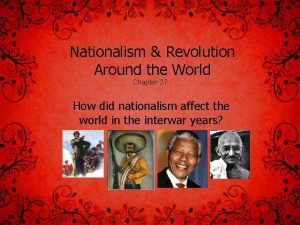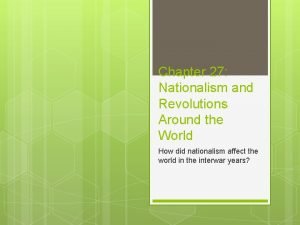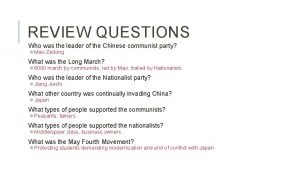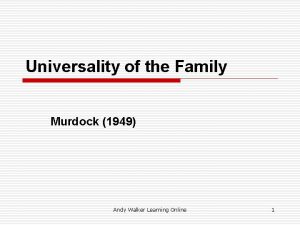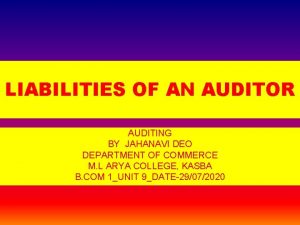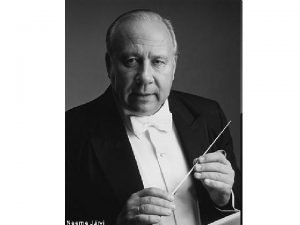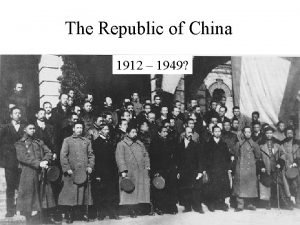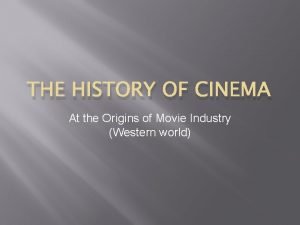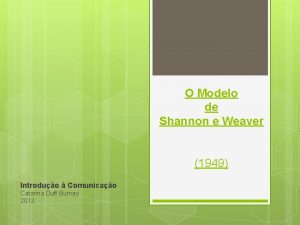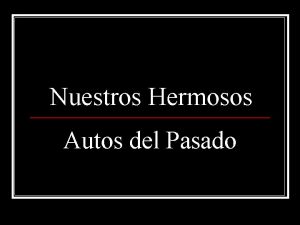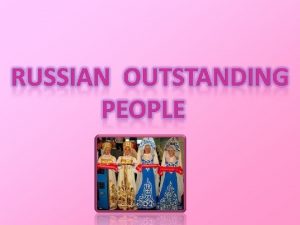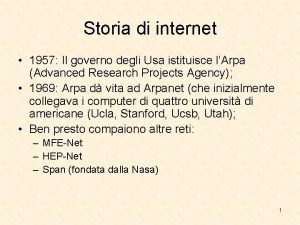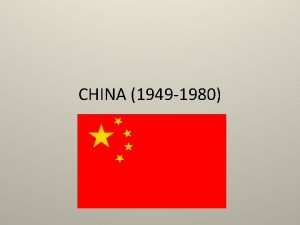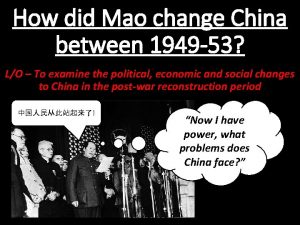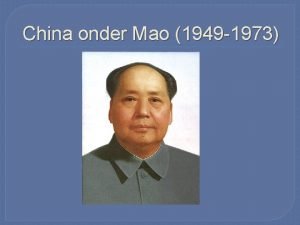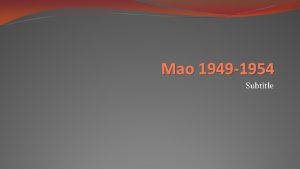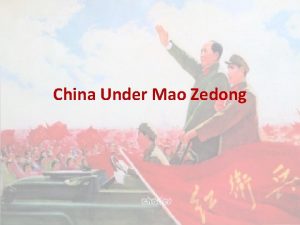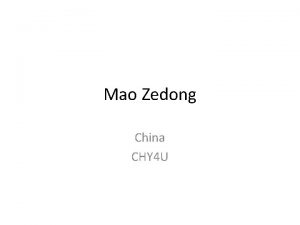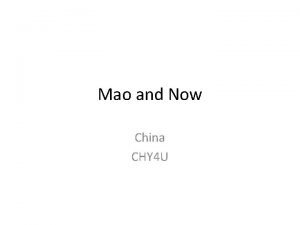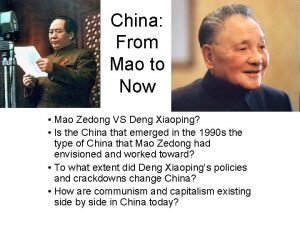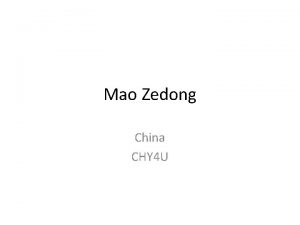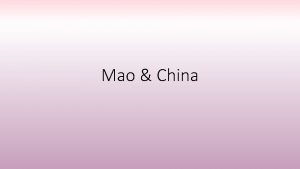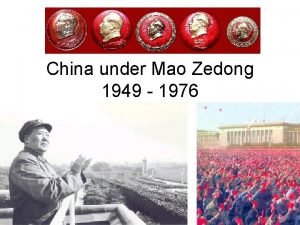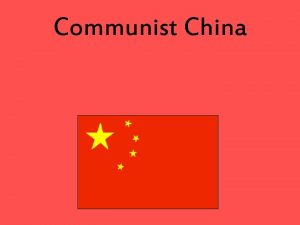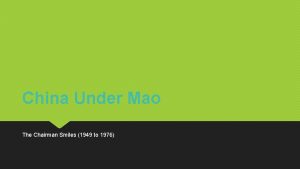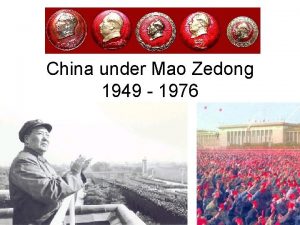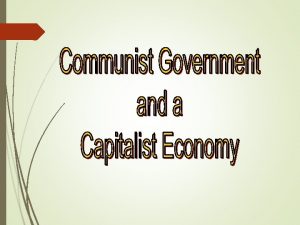How did Mao change China 1949 1957 LO

















- Slides: 17

How did Mao change China 1949 -1957? L/O – To examine the agricultural, industrial and social reforms of the Communists between 19491957

What problems did Mao have in 1949? Try to think about the legacy of the Second World War and Civil War on China Industrial? Social? Economic? Mao’s Problems in 1949 Foreign? Agricultural? Political?

China’s Problems in 1949 Political Economic The CCP had to prove that they were capable of providing a strong and effective government. Opposition to the government had to be removed or brought under control. It was very poor. Industrial production was 50% down on the best pre-war figure and food production was down by 25%. Manchuria, China’s most industrialised region, had been occupied by the Japanese. There was rapid inflation. Social Foreign Most of the people were peasants who could not read or write. The Chinese people did not want change. They mistrusted all modern ideas in farming, industry, education, medicine and women’s rights. Most of the world refused to recognise the CCP. The USA continued to recognise the Kuomintang in Taiwan. Only the Soviet Union would help the new China.

How did Agriculture change? • In 1950 Mao introduced an Agrarian Reform Law. He sent CCP workers into each village to enforce it. • They took the land from landlords and shared it out amongst village peasants. • They also got peasants to put landlords on trial in so-called ‘People’s Courts’.



People’s Courts • At these trials the landlords were accused of charging high rents or mistreating their tenants. • Some were let off, but many landlords were imprisoned or executed. Party workers set up the courts but peasants ran them. Why? • Between 700, 000 – 3 million landlords were executed. This further increased support and faith in Mao. Why? Mao wanted the executions to have maximum impact by involving peasants in the killing and having executions in public: “Peasants who killed with their bare hands the landlords who oppressed them were wedded to the new revolutionary order in a way that passive spectators could never be. ” From P. Short, Mao: A Life, 1999

Population ↑, Food Production ↓ = ? • Land reform made Mao popular but in the short-term it only decreased productivity. • Mao eventually planned to ‘collectivise’ farming to raise productivity, but this would only anger peasants who has just won their own land. • The population was growing and to avoid famine, Mao slowly tried to persuade peasants to work together to raise food production.

Mutual Aid Teams • His first step was to introduce Mutual Aid Teams. • Peasants worked on each other’s land, fertilising, killing pests or harvesting so that each family’s plot would become more productive. • Government supplied extra fertiliser & tools to reward hardworking families but it did not raise productivity enough. “In 1951 we set up a Mutual Aid Team. The work went well, but there were lots of quarrels about whose land should be worked on first. It was difficult to solve all these problems. Some said ‘Why should his field be taken first? I’ve got a bigger crop. ’ Whatever we did this went on. So we then began to talk about forming a peasant’s cooperative. ”

The Co-operatives • From 1953, Mao encouraged peasants to form co-operatives. • This meant land was jointly owned so one large crop could be grown efficiently. Resources could be pooled to buy equipment, fertilisers & seeds. • Some peasants opposed this (Why? ) but by 1957, over 90% of China’s peasants belonged to co -operatives.

Food Production in China: Billions of Kg of Food Produced 1949 -1957 250 f 1953 – All peasants encourage to join co-operatives 1950 Agrarian Land Reform 200 150 1957 – Over 90% of peasants now in co-operatives 100 1951 – Mutual Aid Teams set up 50 0 1949 1950 1951 1952 1953 1954 1955 1956 1957

How did Agriculture Change? Use pages 268 -269 of Modern World History to help you answer the following questions: 1. What was Chinese farming like before 1949? 2. How did peasants deal with the landlords? 3. How did farming methods change? 4. Did peasants attitudes to reforms change over time? 5. Were the changes in farming successful?

How did Industry change? • When the CCP took over the economy was in ruins. Industry had been destroyed and inflation was over 1000%. • Mao introduced a series of measures to deal with this chaos: 1. Mao ordered prices and wages to be fixed at a low rate. He punished black marketeers severely. Inflation was down to 15% within a year. 2. He increased the taxes paid by business and in 1953 took over all businesses. Government planned and organised what should be produced. 3. He took over private banks and introduced the ‘People’s Bank’ in 1951. This helped to stabilise the currency. 4. Railway links were repaired and taken over by government so that industries could be supplied with coal.

The Five Year Plan 1953 -1957 • By 1953 the economy had stabilised and Mao began the first 5 Year Plan. • With the help of the USSR he began an ambitious programme to build new industries. • Thousands of Russian scientists and engineers supervised millions of Chinese on over 700 major projects. Why do you think Mao used help from the USSR?

The Five Year Plan 1953 -1957 • The focus was on heavy industries – steel, coal, chemicals. These would provide the raw materials to build planes, trains and engines which would improve transport. • Why was the emphasis of the Five-Year Plan on heavy industry?

The Five Year Plan 1953 -1957 • The plan achieved astounding results. Motivated Chinese workers surpassed all the targets. • In five years, China was crisscrossed with railways which moved vital goods over vast distances. • The population of cities soared as peasants moved to the jobs created in the new industries.

Social Reforms • During the 1950 s Mao attempted to modernise and reform many other aspects of life in China such as: Look at page 271. Make a spider diagram of the major social changes. Education Women’s Rights Healthcare Sanitation What do you think was the purpose of these reforms?
 Nationalism and revolution around the world
Nationalism and revolution around the world When did mao take over china
When did mao take over china 1927-1949
1927-1949 Mao mao
Mao mao Murdock 1949
Murdock 1949 Criminal liabilities of an auditor
Criminal liabilities of an auditor Equity charitable trust
Equity charitable trust Happy loman
Happy loman Helilooja 1949-2001
Helilooja 1949-2001 1949-1912
1949-1912 The ten commandments 1956
The ten commandments 1956 Modelo shannon e weaver
Modelo shannon e weaver Lahalibo 1949
Lahalibo 1949 Pagkontrol sa mga kilos at gawi ng tao
Pagkontrol sa mga kilos at gawi ng tao 1949 cadillac series 62 4 door
1949 cadillac series 62 4 door Plan marshall affiche
Plan marshall affiche Boris mikhailovich pugachev
Boris mikhailovich pugachev Internet 1957
Internet 1957
